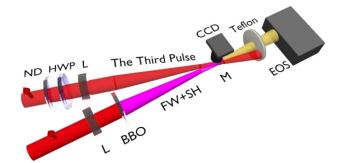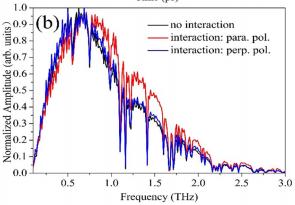We experimentally demonstrated that nonlinear filament interaction could spectrally modulate terahertz (THz) radiation generated from asymmetric two-color filaments. It was the spatial plasma density modulation in plasma channels that induced the THz spectral modulation. As a result of optical manipulation of electron density in the filamentary plasma gratings, the proportion of high-frequency THz spectra increased, while that of low-frequency THz spectra decreased, indicating that the increase of free electron density in the filamentary plasma grating brought about THz frequency upshifts.

Fig. 1. Schematic diagram of THz modulation induced by the plasma grating formed via nonlinear interaction of two 800-nm laser pulses. ND: neutral density filters, HWP: half-wave plate, L: lens, BBO: β-barium borate Type-I crystal, CCD: charge coupled device, M: microscope, EOS: electric-optic sampling setup

Fig. 2. THz electric fields (b) generated by two-color filaments without plasma grating (black curve), with plasma grating formed by parallel-polarized (red curve) and perpendicularly polarized (blue curve) filaments, respectively. The dependence of the THz amplitude at 1.52 THz (blacksquared solid curves) and 0.50 THz (red-circled solid curves) on the relative angle
![]() Terahertz modulation induced by filament interaction, Opt. Lett..pdf
Terahertz modulation induced by filament interaction, Opt. Lett..pdf

